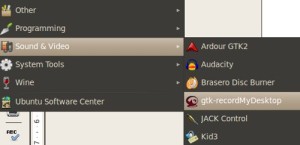This is a tutorial about how to record your screen activity in Ubuntu. Ideally with respect to audio recording and mixing in Linux environment using Ardour digital audio workstation. There are times when you need to record screen activity procedures for documentation purposes. Performing recording and mixing process can be a delicate procedure and if you are beginner it would be nice if you can record the important mixing steps and recording procedures so that you won’t get lost in the future.
Writing the steps in the text manner may be good but its not entirely accurate and can be time consuming. The best way is to record the procedure directly on the screen. In Ubuntu, the best screen recorder is “Record My Desktop”. This is free, high quality screen recording software and highly configurable. Below are the procedures to make this work in your Ubuntu computer:
Note: This tutorial is written on Ubuntu 10.04/Linux, otherwise known as Lucid Lynx.
Step1) Go to Applications – Ubuntu Software Center – in the search box type recordmydesktop , see screenshot below:
Out of the results, select “gtk-recordMyDesktop” and click “Install”. You are then required to enter your root Linux password. The installation process is easy and straightforward.
Step2) Confirm if you have successfully installed the screen recorder by going to Applications – Sound & Video and you should see “gtk-recordMyDesktop”.
Step3.) Let’s try launching screen recorder. Go to Applications – Sound & Video – gtk-recordMyDesktop. This is how it looks like:
You will be asked to select a portion of your Desktop to record. You can click “Select Window” and start selecting the regions. It is not advisable to record the entire screens of your Desktop because the file sizes of the generated video can be extremely large.
Step4.) Once you have actively select the regions. Try clicking “Record” and do something in your Ubuntu Desktop. This will record your screen activity. By default , all movie file generated will be save to your home folder.
Step5.) After you have clicked stop; the software will encode your video and you will see the “WARNING” not to close it while encoding. After everything has been done, go to Places – Home Folder.
The file extension of the generated movie is .ogv, by default the file name is out.ogv.
Common Problems Encountered:
1.) No sound included in the screen capture/activity for Record my Desktop:
Solution:
a.) Go to Applications – Accessories – Terminal
b.) In the command prompt, type this command: aplay -l
c.) You should then see the list of sound devices detected by Ubuntu. For example is an example output:
**** List of PLAYBACK Hardware Devices ****
card 0: CA0106 [CA0106], device 0: ca0106 [CA0106]
Subdevices: 0/1
Subdevice #0: subdevice #0
card 0: CA0106 [CA0106], device 1: ca0106 [CA0106]
Subdevices: 1/1
Subdevice #0: subdevice #0
card 0: CA0106 [CA0106], device 2: ca0106 [CA0106]
Subdevices: 1/1
Subdevice #0: subdevice #0
card 0: CA0106 [CA0106], device 3: ca0106 [CA0106]
Subdevices: 1/1
Subdevice #0: subdevice #0


